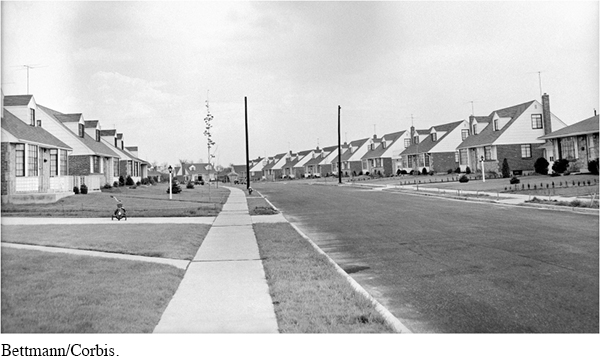Burgeoning Suburbs and Declining Cities
Although suburbs had existed since the nineteenth century, nothing symbolized the affluent society more than their tremendous expansion in the 1950s. Eleven million new homes went up in the suburbs, and by 1960 one in four Americans lived there. Suburban homes were accessible to families with modest incomes, as Vice President Nixon boasted to Khrushchev during the kitchen debate, a heated discussion by the display of American consumer goods at the American National Exhibition in Moscow in July 1959. Builder William J. Levitt adapted the factory assembly line to home construction, erecting nearly identical units so that workers moved from house to house performing one specific job. In 1949, families could purchase mass-produced houses in his 17,000-home development, called Levittown, on Long Island, New York, for just under $8,000 each ($80,000 in 2016 dollars). Similar developments, as well as more luxurious ones, quickly went up throughout the country. The government subsidized home ownership by guaranteeing low-interest mortgages and by making interest on mortgages tax deductible. Government-funded interstate highways running through metropolitan areas also encouraged suburban development. [[LP Photo: P27.09 Air-Conditioning/

By the 1960s, suburbs came under attack for bulldozing the natural environment, creating groundwater contamination, and disrupting wildlife patterns. Social critic Lewis Mumford disparaged suburbia as “a multitude of uniform, unidentifiable houses in a treeless communal wasteland, inhabited by people of the same class, the same income, the same age group.” Yet most families were thrilled to be able to own new homes. “It was a miracle to them,” one man said of his working-class parents who moved to Levittown.

> TRACE CHANGE
OVER TIME
How did the white working class live in the prosperous postwar years, and how had their lives changed since the 1930s?
The suburbs did help polarize society, especially along racial lines. Each Levittown homeowner signed a contract pledging not to rent or sell to a non-Caucasian. The Supreme Court declared such covenants unenforceable in 1948, but suburban America remained severely segregated. Although some African Americans joined the suburban migration, most moved to cities in search of economic opportunity, doubling their numbers in major cities during the 1950s. But those cities were already in decline, losing not only population but also commerce, industry, and jobs to the suburbs or to southern and western states. “Detroit is in the doldrums,” commented social worker Mary Jorgensen in 1952.
Understanding the American Promise 3ePrinted Page 779
Section Chronology